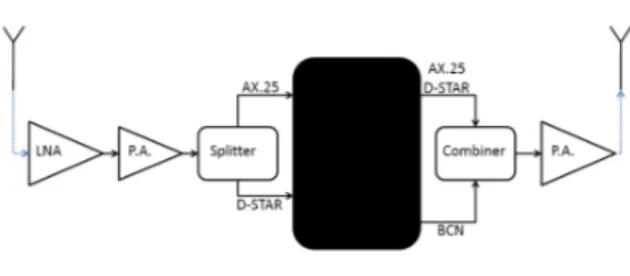Radio-frequency receive front-end
and transmit back-end of the OUFTI-1 nanosatellite
Lo¨ıc Questiaux&, Amandine Denis†, Jonathan Pisane∗,Danielle Vanhoenacker-Janvier&, Jacques Verly∗ &Microwave Laboratory, Universit´e catholique de Louvain, Louvain, Belgium
Tel : +32 4 366 2642, Fax : +32 4 366 2989, E-mail : loic.questiaux@student.uclouvain.be
∗Dept. of EECS, University of Li`ege, Grande Traverse 10, 4000, Li`ege, Belgium †LTAS, University of Li`ege, Chemin des Chevreuils 3, 4000, Li`ege, Belgium
We describe a part of the radiocommunication system of the 1 l, 1 kg, and 2 W
OUFTI-1 CubeSat. We focus on the radiofrequency (RF) parts directly connected to the receive (Rx) and transmit (Tx) antenna. Figure 1 shows the overall radiocommunication architecture. The main feature and payload of the satellite is a D-STAR repeater. The AX.25 is used for telecommands (TM) and telemetries (TC). The Morse-code beacon provides health information about the satellite.
Figure 1 – Architecture of the RF system
The D-STAR and the AX.25 systems must be able to receive simultaneously. The RF front-end thus amplifies the Rx signal, and then split it to the D-STAR and AX.25 trans-ceivers. The RF back-end merges the potential signals from two of the three transceivers (BCN and D-STAR or AX.25) operating in Tx mode, and then power amplifies the resul-ting composite signal. This paper focus on the design, implementation, and tests of the two RF “ends” to meet the requirements of the link budgets and available electrical power.
The 1st RF block consists of a low-noise amplifier (LNA), a power amplifier, and a
splitter. The Rx signal is around -130 dBm at input. The 2nd RF block consists of a
combiner and an amplifier. The design of the amplifier is challenging ; it must have a gain of 25 dB at 145 MHz, with an efficiency of about 65% to 75% ; and must operate at 7.2 V. This second amplifier is home-made. We also performed preliminary tests of the radiation pattern and the input impedance of the Rx and Tx antennas to assess the influence of the metal frame. The final design, built prototypes, and corresponding experimental results will be presented at the workshop.
